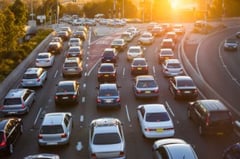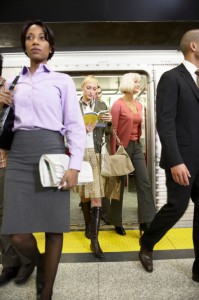If you’re among the ranks of the standard American commuter, your morning routine is probably worthy of an Olympic medal. Between sips of too-hot coffee you somehow make it out the door with cell phone in hand. On the way, you might be checking traffic on a maps app, keeping up with what’s new on the radio, and maybe making a few calls. There’s a good chance breakfast today will be something from a drive-thru. If you wear makeup, there’s an even better chance that you’ll apply it during the drive. Somehow after dropping off the kids and maneuvering around that accident on the highway, you pull up to work, McMuffin in hand, quietly patting yourself on the back for another successful, just-in-time morning.
We are a society on the go. The average commuter spends 20 hours and 16 minutes each week on the road (according to a 2013 Arbitron report), which is certainly long enough to multitask – or to become bored. This article will explore the most effective ways that brands can reach their audience during the daily commute.
Reaching drivers
 It’s difficult to be innovative for an audience that has occupied hands and attention. While it has been done (check out Coca-Cola’s Rush Hour Cinema), it is oftentimes not the most economical choice. Luckily, more traditional forms of advertising are still proving effective. Their messages are not going unnoticed; according to the same Arbitron report mentioned above, “over 8 in 10 billboard viewers make a point to look at the advertising message at least some of the time.” Billboards might feel archaic, but they’re working. Given that many drivers stop at the grocery store or take-out on the way home, a well-positioned billboard can also bring in spontaneous visits. Advertisers should seek ways to make billboards more eye-catching (see Ikea’s RGB “magic” billboard) and thought-provoking.
It’s difficult to be innovative for an audience that has occupied hands and attention. While it has been done (check out Coca-Cola’s Rush Hour Cinema), it is oftentimes not the most economical choice. Luckily, more traditional forms of advertising are still proving effective. Their messages are not going unnoticed; according to the same Arbitron report mentioned above, “over 8 in 10 billboard viewers make a point to look at the advertising message at least some of the time.” Billboards might feel archaic, but they’re working. Given that many drivers stop at the grocery store or take-out on the way home, a well-positioned billboard can also bring in spontaneous visits. Advertisers should seek ways to make billboards more eye-catching (see Ikea’s RGB “magic” billboard) and thought-provoking.
Radio is also an effective medium for reaching drivers, as are radio-like apps such as Spotify and Pandora. Given that 31% of travelers make purchase decisions in the car, the well-timed auditory ad can effectively influence purchase decisions.
Reaching urban commuters
 It its “World Urbanization Prospects,” the UN predicts that cities will contain 67% of the world’s population by 2050. Our lives are becoming increasingly urban, which means fewer cars and more alternative transit options. In a 2013 study, Mintel reported that 39% of consumers responded that they bike or walk instead of driving whenever possible. The US Department of Transportation also reported that between December 2011 and December 2012, travel on all roads decreased by 2.9%. Alternative transportation is on the rise, opening doors for marketers to reach their audiences in new ways.
It its “World Urbanization Prospects,” the UN predicts that cities will contain 67% of the world’s population by 2050. Our lives are becoming increasingly urban, which means fewer cars and more alternative transit options. In a 2013 study, Mintel reported that 39% of consumers responded that they bike or walk instead of driving whenever possible. The US Department of Transportation also reported that between December 2011 and December 2012, travel on all roads decreased by 2.9%. Alternative transportation is on the rise, opening doors for marketers to reach their audiences in new ways.
Commuters using public transportation have a good deal more freedom than drivers, and often more time as well. Marketers have the opportunity to go beyond bus stop ads and make the trip interesting. We see mass-transit innovations are springing up across the world: In Bucharest, subway users can stop by a life-size “physical digital” library – a QR code lets the travelers download all or part of a book to peruse during their ride. In Paris, the Station Diderot bus stop offers coffee, a mini-library, phone charging stations, and bike rentals. Brands that offer fun, useful enhancements to the mass-transit system will see engagement and a return on their investment.
Whether by bus, plane, bike, or foot, consumers want to be productive and entertained during their daily commute. There is a market for on-the-go services and products to make the trip more enjoyable. Marketers should also take into consideration the lifestyles of commuters beyond the actual commute; for example, students on their way to class will be attracted to different products than businesspeople on the way to work.




